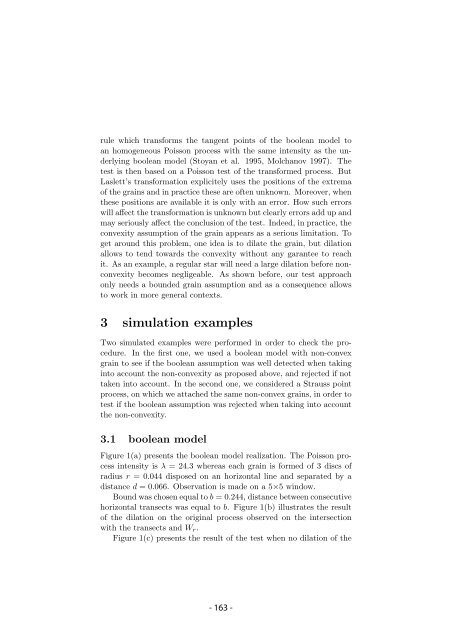Ecole Nationale Supérieure Agronomique de Montpellier ... - CIAM
Ecole Nationale Supérieure Agronomique de Montpellier ... - CIAM
Ecole Nationale Supérieure Agronomique de Montpellier ... - CIAM
Create successful ePaper yourself
Turn your PDF publications into a flip-book with our unique Google optimized e-Paper software.
ule which transforms the tangent points of the boolean mo<strong>de</strong>l to<br />
an homogeneous Poisson process with the same intensity as the un<strong>de</strong>rlying<br />
boolean mo<strong>de</strong>l (Stoyan et al. 1995, Molchanov 1997). The<br />
test is then based on a Poisson test of the transformed process. But<br />
Laslett’s transformation explicitely uses the positions of the extrema<br />
of the grains and in practice these are often unknown. Moreover, when<br />
these positions are available it is only with an error. How such errors<br />
will affect the transformation is unknown but clearly errors add up and<br />
may seriously affect the conclusion of the test. In<strong>de</strong>ed, in practice, the<br />
convexity assumption of the grain appears as a serious limitation. To<br />
get around this problem, one i<strong>de</strong>a is to dilate the grain, but dilation<br />
allows to tend towards the convexity without any garantee to reach<br />
it. As an example, a regular star will need a large dilation before nonconvexity<br />
becomes negligeable. As shown before, our test approach<br />
only needs a boun<strong>de</strong>d grain assumption and as a consequence allows<br />
to work in more general contexts.<br />
3 simulation examples<br />
Two simulated examples were performed in or<strong>de</strong>r to check the procedure.<br />
In the first one, we used a boolean mo<strong>de</strong>l with non-convex<br />
grain to see if the boolean assumption was well <strong>de</strong>tected when taking<br />
into account the non-convexity as proposed above, and rejected if not<br />
taken into account. In the second one, we consi<strong>de</strong>red a Strauss point<br />
process, on which we attached the same non-convex grains, in or<strong>de</strong>r to<br />
test if the boolean assumption was rejected when taking into account<br />
the non-convexity.<br />
3.1 boolean mo<strong>de</strong>l<br />
Figure 1(a) presents the boolean mo<strong>de</strong>l realization. The Poisson process<br />
intensity is λ = 24.3 whereas each grain is formed of 3 discs of<br />
radius r = 0.044 disposed on an horizontal line and separated by a<br />
distance d = 0.066. Observation is ma<strong>de</strong> on a 5×5 window.<br />
Bound was chosen equal to b = 0.244, distance between consecutive<br />
horizontal transects was equal to b. Figure 1(b) illustrates the result<br />
of the dilation on the original process observed on the intersection<br />
with the transects and Wr.<br />
Figure 1(c) presents the result of the test when no dilation of the



